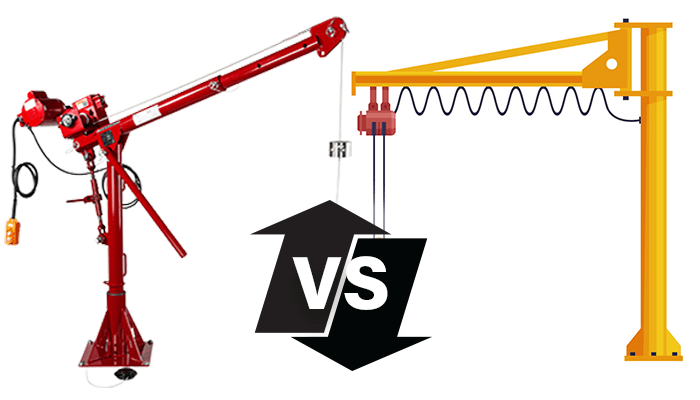Which Crane Is Right for Your Application?
The right crane can make all the difference to the success of your operation — and the wrong one can be an expensive mistake. So when it comes to choosing between davit and jib cranes, you need to be sure you get the best fit and functionality for your situation. While the terms are often used interchangeably, knowing the differences between the two is critical for making the right choice — that’s why we made this guide! We’ll compare the important factors that make the difference between davit and jib cranes so you have the information you need to make the best decision.
What Is a Davit Crane?
Davit cranes typically have a base, vertical mast, a winch or other hoisting method, and a boom (often called an arm or davit arm). The design and construction of davit cranes make them truly unique and flexible lifting and lowering solutions. Davits are durable, but constructed using lightweight materials that make them portable. With a variety of bases and boom optionality, davits are also more modular and flexible than other types of cranes, making them an ideal solution for all types of applications.
What Is a Jib Crane?
Jib is a term that covers a wide range of cranes, but in general they bear some resemblance to davits, with a vertical mast, horizontal boom, and hoist mechanism. Jib cranes are generally designed and installed to do a specific job, which can limit their flexibility. They traditionally use a chain hoist as well, which can make longer lifts difficult.
Key Design Differences Between Davit and Jib Cranes
When comparing davit versus jib cranes, it’s important to go beyond the surface level similarities. Knowing the differences between the two options is key to making the right decision to fit what you need a crane to do.
- Design — davit cranes usually have a more flexible design than jib cranes, with a telescoping boom and an adjustable boom angle
- Mobility — lightweight construction and more flexible mounting allow davits to be more portable than jib cranes, adding key flexibility to your operation
- Installation — for secure installation, jib cranes generally require a footing that is both poured and deep, while davits just need to be anchored to six inches of suitable material, such as reinforced concrete
- Cost — when considering the price of installation and flexibility of applications, davit cranes are the more cost-effective option compared to jib cranes
- Applications — given a relatively limited task set, jib cranes are excellent at individual applications. Davit cranes are better suited for a wider range of uses and their adaptability makes an individual davit more useful across multiple applications
- Customization — from bases to finishes, arms, and adding unique features, davit cranes are more flexible and customizable than jibs, enhancing the value and broadening their application (check out our industry-leading customization services to learn more)
- Operation — davits are easier and safer to operate than jibs, in part because a davit’s winch is located on the back of the crane, versus at the load like a jib crane, and the boom can be rotated with a handle safely away from the load
Which Crane Is Best for You?
When choosing the right crane for your needs, consider all of your options and the job you need done. While jibs may be the right choice in some situations, the flexibility, performance, adaptability, and cost-effectiveness of davit cranes makes them the best option for a much wider range of applications.
If you want to learn more about davit cranes or find one that is best suited for your operation, check out the options from Thern or reach out to our experts with any questions you may have.
